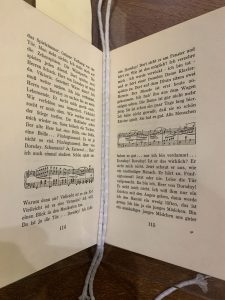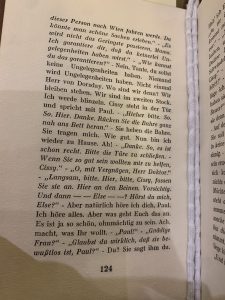Fräulein Else by Sam Swofford
The original German edition of Fräulein Else by Arthur Schnitzler is overall very similar to the English translation. The English edition of the story retained much of the same syntax, word choice, and meanings behind the sentences in the story. There are not many nuances the original German edition contains that the English translation fails to capture. There are, however, some differences that arise due to the two languages having different rules; the rules pertaining to the differences in the translations being those regarding formal and informal pronouns as well as some words that do not retain their original German meaning when translated to English.
Regarding the first difference, in the story, there is a scene near the ending in which Else discovers Paul and Cissy’s relationship due to the way Cissy addresses Paul as they are looking after Else. In the German edition, Cissy uses the pronoun “du”, meaning you, when speaking to Paul. In German, there are two different pronouns someone can use when speaking in second person, “du” and “Sie”. These two pronouns both mean you, however the difference in their use comes down to respect towards the person someone is addressing. Sie is the formal pronoun and is often used when speaking to people you do not know, authority figures, or people in charge of you, such as bosses or teachers. Du, on the other hand, is the informal pronoun and is used with people you know well or are good friends with. The difference between these two forms is not captured in the English translation, as English contains just one second person pronoun. With this, Else’s reaction to Cissy using du as opposed to Sie, which is retained in the English translation, does not make sense in English as it does in German.
Aside from translation differences or content differences, both of which there are very few, the only other notable differences come from the formatting of the German edition. Unlike the English translation, which makes use of italicized font for all dialogue, the German edition only uses italicized thought for dialogue of other people. All of Else’s text, thoughts or dialogue, is written normally; the font does not distinguish between her thoughts and dialogue. The other noteworthy difference is that the German edition commits much more to the “stream of consciousness” writing style Schnitzler uses. There are hardly any lines skipped between paragraphs and most of the text seems to blend together into one continuous stream of words throughout the entire book. Overall, I think this decision to structure the story as one, unending stream of text adds much more realism and validity to the idea that the entire story is simply Else’s stream of consciousness as the events unfold.











Recent Comments